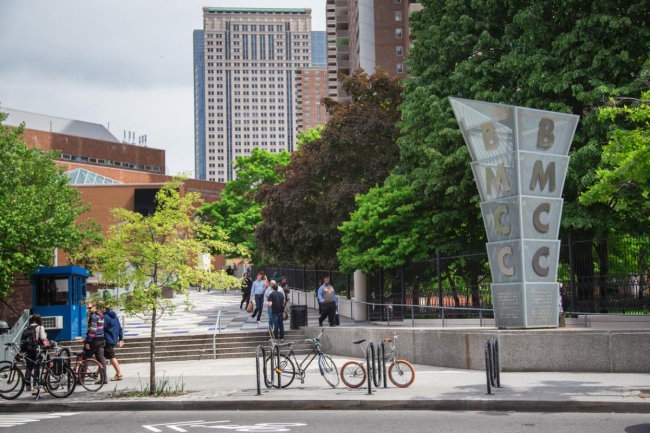You have /5 articles left.
Sign up for a free account or log in.

Borough of Manhattan Community College is one of the colleges in CUNY ASAP.
ISTOCK.COM/littleny
The Accelerated Study in Associate Programs at the City University of New York is widely considered one of the most successful programs in higher education for improving outcomes of low-income students.
Students in CUNY ASAP had a graduation rate 18 percentage points higher compared to their peers not in the program, according to a study by MDRC, a nonprofit education research organization. Three years into the study, researchers found that 25 percent of students in the program were enrolled in a four-year college, compared to 17 percent of the students in the control group.
The outcry, then, over a potential budget cut to the program was to be expected.
The New York City mayor's office includes a $20 million cut to CUNY ASAP in its proposed budget for financial year 2021. The cut would come from temporarily delaying a new cohort of freshmen for the program this fall.
City Council members took to Twitter and local news outlets to complain about the proposal.
“The ASAP program has been a lifeline for students pursuing associate degrees in the face of tremendous hardships,” Councilman Fernando Cabrera told the Bronx Times. “At this critical time when the COVID-19 pandemic is showing us the deadliness and potential fatality of racial disparities, how can we end the programs that lead the way out of poverty?”
Siobhan Dingwall, city hall spokeswoman, said the city had little choice.
"The City has lost billions of dollars in tax revenue due to the pandemic," she said in an emailed statement. "In the face of these dire circumstances, we're focused on saving lives, protecting the health and safety of New Yorkers, and making sure everyone has a roof over their head and enough food to eat. We are currently working with City Council to finalize the budget and will have more to share soon."
CUNY ASAP is one of very few programs in higher education to have received rigorous evaluation by MDRC and to be found to be successful, according to Michael Weiss, senior associate of postsecondary education policy at MDRC.
The nonprofit compared a control group of students to those in the program, which is considered a gold standard for research. The outcomes of the program were huge. Even after eight years, there was still a 10-percentage-point lead in graduation rates for ASAP students. The program was replicated at community colleges in Ohio, with similar success.
"It's been seen as a national beacon," Weiss said. "To have this program that already was seen as exceptional then be proven effective again in a new context is kind of unusual."
But, like many programs aimed at helping students improve their social mobility, CUNY ASAP is expensive. Students in the program receive tuition and fee waivers, monthly transit passes, textbook stipends, tutoring, intensive advising, and career counseling.
CUNY spent about $5,000 more on ASAP students than non-ASAP students when the program first began, according to Weiss. The system has been able to whittle the costs down over the years to about $3,000 more per student compared to those not in the program.
The program is also more cost-effective in the long run when it comes to CUNY students earning degrees. Because students complete their studies more quickly, the costs per degree earned were about $13,400 less for students in CUNY ASAP, according to the MDRC study.
CUNY officials did not respond to requests for comment by deadline.
Other higher education experts are also unhappy about the pending cuts and worry what it could mean for similar programs at other colleges.
"Truly, I'm devastated to hear that it is potentially on the chopping block," said Thomas Brock, director of the Community College Research Center at Columbia University's Teachers College. "I would just hope that perhaps the city could be more creative or entrepreneurial."
Brock hopes the city will work with philanthropies to find funding to fill any spending gaps created by the budget cut.
"I really understand the budget crisis in New York," he said. "But here’s an example of a program that we know, as a fact, makes a substantial difference and actually saves taxpayers [money] in the long run."
Brock and others worry the proposed cut could foreshadow other funding reductions for similar student success programs and services elsewhere due to the coronavirus-induced recession.
"I think we’re going to see this trend all around the country," Brock said, adding that he is worried that cuts will go beyond specialized programs to core services at community colleges, such as instruction and basic student services.
"Greater reductions in these kinds of services leads to reductions in student outcomes," he continued. "I absolutely think there are long-term consequences."
Weiss hopes the budget cut isn't a canary in the coal mine. He said he expected ASAP to be modeled by other institutions and to be "spreading like wildfire" due to its proven effectiveness, but that did not happen because of the high costs of administering and maintaining the program. Cuts to the program could also deter other colleges from implementing the model.
Brock and others argue that student success programs such as ASAP benefit communities and employers, especially during times of economic uncertainty.
"Higher education is an investment in people. It helps create this kind of prosperity that I think we all are looking for," he said. "While I understand the very real budget pressure, to make cuts here feels to me the exactly wrong move that policy makers should be making."








